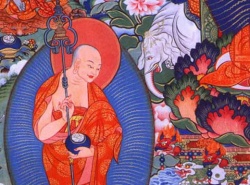Difference between revisions of "Buddha Infinite Life Sutra"
| Line 4: | Line 4: | ||
[[無量寿経]] (Skt [[Sukhavativyuha]]; Chin [[Wu-liang-shou-ching]]; Jpn [[Muryoju-kyo]] ) | [[無量寿経]] (Skt [[Sukhavativyuha]]; Chin [[Wu-liang-shou-ching]]; Jpn [[Muryoju-kyo]] ) | ||
| − | One of the three basic [[scriptures]] of the [[Pure land]] school, the other two [[being]] [[The Amida Sutra]] and the [[Meditation]] on [[The Buddha]] [[Infinite Life Sutra]]. [[The Buddha]] [[Infinite Life Sutra]] is also called the Two-Volumed [[Sutra]] because it alone among the three consists of two volumes. It relates how a [[Bodhisattva]] named [[Dharma]] Treasury (Skt [[Dharmakara]]) made [[forty-eight vows]] and, on fulfilling them, achieved [[Enlightenment]] as [[The Buddha]] [[Infinite]] [[Life]], or [[Amida]] (Skt [[Amitayus]]). The [[Sutra]] describes this [[Buddha]]'s [[Pure land]], known as Perfect [[Bliss]], located "a hundred thousand million [[Buddha]] lands to the {{Wiki|west}}," and explains that one can be [[reborn]] there after [[Death]] if one has [[Faith]] in [[Amida]]. Twelve | + | One of the three basic [[scriptures]] of the [[Pure land]] school, the other two [[being]] [[The Amida Sutra]] and the [[Meditation]] on [[The Buddha]] [[Infinite Life Sutra]]. [[The Buddha]] [[Infinite Life Sutra]] is also called the Two-Volumed [[Sutra]] because it alone among the three consists of two volumes. It relates how a [[Bodhisattva]] named [[Dharma]] Treasury (Skt [[Dharmakara]]) made [[forty-eight vows]] and, on fulfilling them, achieved [[Enlightenment]] as [[The Buddha]] [[Infinite]] [[Life]], or [[Amida]] (Skt [[Amitayus]]). The [[Sutra]] describes this [[Buddha]]'s [[Pure land]], known as Perfect [[Bliss]], located "a hundred thousand million [[Buddha]] lands to the {{Wiki|west}}," and explains that one can be [[reborn]] there after [[Death]] if one has [[Faith]] in [[Amida]]. Twelve {{Wiki|Chinese}} versions of this [[Sutra]] are said to have existed, but only five are extant, of which [[The Buddha]] [[Infinite Life Sutra]], translated by the [[Indian]] [[Monk]] [[Samghavarman]] in 252, is the most popular. |
</poem> | </poem> | ||
{{R}} | {{R}} | ||
Revision as of 06:31, 11 September 2013
Buddha Infinite Life Sutra
無量寿経 (Skt Sukhavativyuha; Chin Wu-liang-shou-ching; Jpn Muryoju-kyo )
One of the three basic scriptures of the Pure land school, the other two being The Amida Sutra and the Meditation on The Buddha Infinite Life Sutra. The Buddha Infinite Life Sutra is also called the Two-Volumed Sutra because it alone among the three consists of two volumes. It relates how a Bodhisattva named Dharma Treasury (Skt Dharmakara) made forty-eight vows and, on fulfilling them, achieved Enlightenment as The Buddha Infinite Life, or Amida (Skt Amitayus). The Sutra describes this Buddha's Pure land, known as Perfect Bliss, located "a hundred thousand million Buddha lands to the west," and explains that one can be reborn there after Death if one has Faith in Amida. Twelve Chinese versions of this Sutra are said to have existed, but only five are extant, of which The Buddha Infinite Life Sutra, translated by the Indian Monk Samghavarman in 252, is the most popular.
